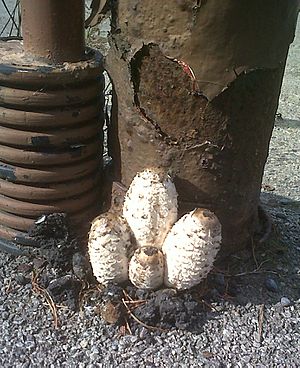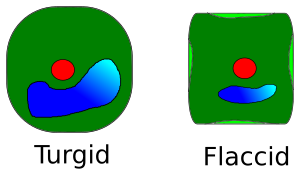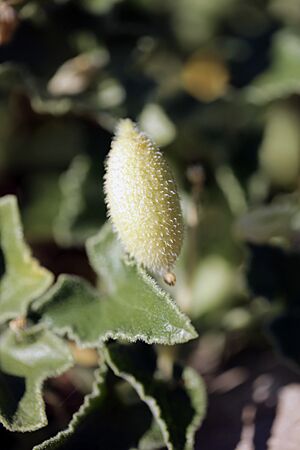Turgor pressure facts for kids
Turgor pressure is the force inside a cell that pushes the outer layer, called the plasma membrane, against the cell wall. Think of it like blowing up a balloon inside a box – the balloon pushes against the sides of the box.
This pressure is also known as hydrostatic pressure. It happens when water moves into a cell through a process called osmosis. Turgor pressure is common in plants, fungi, and bacteria. Some tiny living things called protists that have cell walls also show this. Animal cells don't have cell walls, so they can't have turgor pressure. If too much water enters an animal cell, it might burst!
Contents
How Turgor Pressure Works
Osmosis is a special way water moves. Water always tries to move from an area where there's a lot of water (and not many dissolved things, called solutes) to an area where there's less water (and more solutes). This movement continues until the amount of water is balanced on both sides.
All cells have a thin outer layer called a cell membrane. This membrane lets water pass through easily but controls what other substances can enter or leave.
- If a cell is in a solution with more solutes outside (a hypertonic solution), water will leave the cell. This makes the cell shrink.
- If a cell is in a solution with fewer solutes outside (a hypotonic solution), water will rush into the cell. This makes the cell swell up.
- If the solution outside has the same amount of solutes as inside (an isotonic solution), water moves in and out equally, so the cell stays the same size.
When a cell has high turgor pressure, its membrane is pushing hard against the cell wall. We say the cell is turgid. When the pressure is low, the cell is soft or floppy, which is called flaccid. In plants, this is why leaves might look wilted when they don't have enough water. This wilting is also known as plasmolysis.
The size and shape of a cell can change how much turgor pressure it experiences. Smaller cells tend to change more when the pressure changes compared to larger cells. Turgor pressure is also very important for plant cells to grow. It helps the cell wall stretch and expand.
Turgor Pressure in Plants
Turgor pressure helps plants stay stiff and upright. It's also key for their growth. When a plant doesn't have enough water, its cells lose turgor pressure, and the plant starts to wilt.
Plants have ways to control turgor pressure:
- Their semipermeable membrane lets only some substances in and out, helping to keep the right pressure.
- Transpiration is when plants lose water vapor from their leaves. This can lower turgor pressure.
- Turgor pressure also helps move nutrients around the plant.
Different parts of the same plant can have different turgor pressures. In larger plants, turgor pressure helps with the growth of root tips and pollen tubes.
Seed Dispersal
For some fruits, like the squirting cucumber, turgor pressure is how they spread their seeds. The pressure builds up inside the fruit until it bursts off its stalk. This shoots seeds and water everywhere as the fruit falls. The pressure inside these fruits can be very high, much stronger than a car tire!
Plant Growth
Turgor pressure is often seen as the main force driving cell growth in plants. When water moves into a cell, the turgor pressure increases, causing the cell to expand. This expansion helps root tips, pollen tubes, and other plant parts grow.
The pressure inside a growing root cell can be very high, strong enough to help plants grow through hard surfaces like asphalt!
Stomata and Water Control
Tiny pores on plant leaves, called Stomata, open and close to control how much water vapor leaves the plant. This process is called transpiration. Turgor pressure inside the cells surrounding the stomata controls whether they are open or closed.
- If the plant has plenty of water, turgor pressure is high, and the stomata stay open. This allows gases like carbon dioxide to enter for photosynthesis.
- If the plant is losing too much water, turgor pressure drops, and the stomata close. This helps the plant save water.
Mimosa pudica
The Mimosa pudica plant, also known as the "touch-me-not" plant, famously folds its leaves when touched. This quick movement is caused by a sudden loss of turgor pressure in special cells at the base of its leaves. When touched, these cells quickly lose water, causing the leaves to droop.
Turgor Pressure in Other Living Things
Turgor pressure isn't just for plants. It plays a role in the lives of other organisms too.
Fungi

In fungi, turgor pressure helps them push into surfaces. For example, some fungi can use this pressure to break through plant cells or even tough materials like plastic. The growth of their thread-like structures, called hypha, is directly linked to turgor pressure. High pressure helps them grow and invade.
Protists
Some protists don't have cell walls, so they can't have turgor pressure. Instead, they have a special part called a contractile vacuole. This vacuole acts like a tiny pump, pushing excess water out of the cell to keep the water balance just right.
Animals
Animal cells do not have cell walls. Because of this, they don't experience turgor pressure. If too much water enters an animal cell, it would swell and burst, a process called lysis. The cell wall in plants and fungi protects them from this.
Cyanobacteria
Some cyanobacteria (often called blue-green algae) can float because they have gas-filled sacs inside them. Scientists have found that higher turgor pressure in these bacteria can actually reduce the size of these gas sacs, affecting their ability to float.
Measuring Turgor Pressure
Measuring turgor pressure in plants can be tricky. A cell that is fully turgid (full of water) has high turgor pressure, while a flaccid cell (low water) has pressure close to zero.
Scientists use different methods to measure turgor pressure, depending on the organism and what they want to study.
Units of Measurement
Turgor pressure is usually measured in units like bars, MPa (megapascals), or newtons per square meter. One bar is equal to 0.1 MPa.
Measurement Methods
Pressure Bomb Technique
The pressure bomb is a tool used to measure water movement in plants. A plant leaf with its stem is placed inside a sealed chamber. Gas pressure is slowly added. Scientists watch for when sap (the plant's liquid) starts to appear from the cut end of the stem. This point helps them figure out the turgor pressure.
Atomic Force Microscope
An atomic force microscope uses a tiny probe to measure very small forces. This method can be used to measure the turgor pressure of individual cells. By combining these measurements with other information about the cell's shape, scientists can calculate the exact turgor pressure.
Pressure Probe
The pressure probe is a device that can measure turgor pressure by inserting a tiny glass tube into a cell. The tube measures how much pressure is needed to push the cell's contents back into the cell. This method is often used for larger plant cells.
Micro-manipulation Probe
These probes are used for even smaller cells. For example, scientists have used them to gently press on single tomato cells while a pressure probe measures their turgor pressure.
Images for kids
See also
 In Spanish: Turgencia para niños
In Spanish: Turgencia para niños









